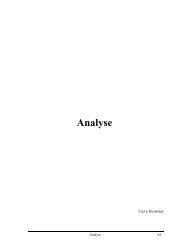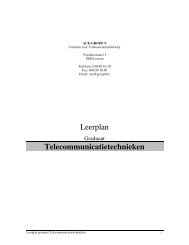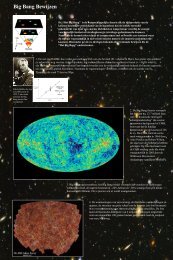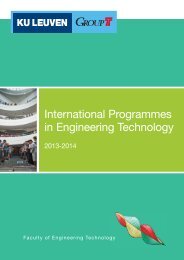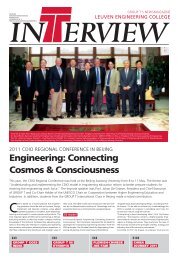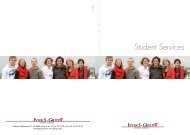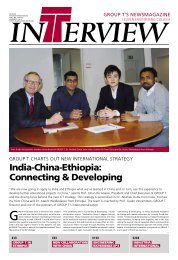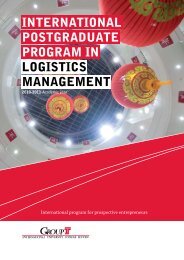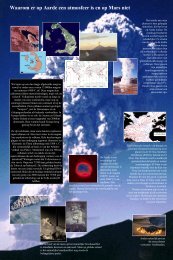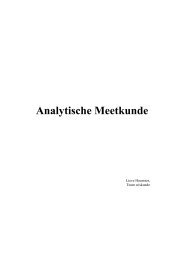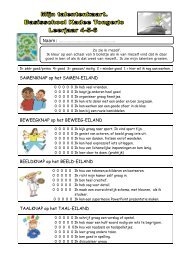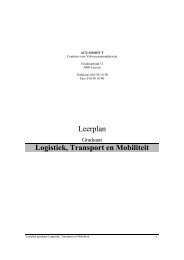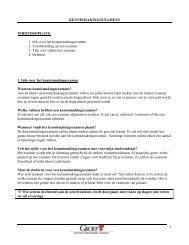Group t and Beijing Jiaotong university open International ... - Groep T
Group t and Beijing Jiaotong university open International ... - Groep T
Group t and Beijing Jiaotong university open International ... - Groep T
You also want an ePaper? Increase the reach of your titles
YUMPU automatically turns print PDFs into web optimized ePapers that Google loves.
Dr. Inge Holsbeeks,<br />
manager of the<br />
Life Technology unit.<br />
Researcher in the spotlight<br />
Engineering to the bone<br />
Tissue engineering is the research domain where engineers, biologists <strong>and</strong> surgeons meet. It is a<br />
combination of cells, engineering, material sciences <strong>and</strong> biochemical <strong>and</strong> physiochemical elements with<br />
the purpose of relieving biological functions but also repairing or replacing damaged tissues like bone.<br />
The latter is what Dr. Inge Holsbeeks, manager of the Life Technology unit, deals with. She is a member of<br />
the Prometheus research group <strong>and</strong> deals with growing full bone tissue out of bone cells in the controlled<br />
environment of a bioreactor.<br />
Tissue engineering is a true multidisciplinary<br />
domain,” Inge explains. “One of the most<br />
common definitions describes it as ‘the application<br />
of the principles of engineering <strong>and</strong> life<br />
sciences toward the development of biological substitutes<br />
that restore, maintain, or improve tissue function<br />
or a whole organ’. The starting point is that using the<br />
natural biology of an organ or body part offers more<br />
chances of success for the replacement, the recovery,<br />
maintenance or improvement of it than other methods.<br />
In other words, if you underst<strong>and</strong> how tissues grow <strong>and</strong><br />
develop themselves, then you can apply these insights<br />
to producing new tissue for clinical use. It is no coincidence<br />
that tissue engineering is often named together<br />
with regenerative medicine although this comparison<br />
is not entirely valid. In regenerative medicine for<br />
instance, there is a greater use of stem cells, while tissue<br />
engineering mostly works with existing, already<br />
functional cells as engineering material.”<br />
Smart mechanisms<br />
From a young age, Inge’s interest was in sciences,<br />
biology in particular appealed to her but so did<br />
engineering. Her study choice, then, was obvious:<br />
Bioengineering at the K.U.Leuven, majoring in Cell<br />
<strong>and</strong> Gene Biotechnology. Her thesis dealt with making<br />
banana plants resistant to viruses <strong>and</strong> infections<br />
by introducing an extra gene. “Very interesting<br />
research,” Inge says. “Only it is a long time before<br />
you see any results. Transforming cells takes time. It<br />
is mainly waiting for a mature plant.”<br />
After graduation, Inge remained associated with the<br />
Bioengineering faculty as an assistant. In the framework<br />
of her Ph.D., she researches how bakers’ yeast<br />
can detect nutrients in its vicinity. “These are really<br />
smart mechanisms that are able to trace nutritious<br />
components like amino acids or nitrogen components<br />
before they are absorbed. In other words, they anticipate<br />
<strong>and</strong> do not simply react to what presents itself.”<br />
Research focus points<br />
In 2004, Inge obtained her doctoral degree at the K.U.<br />
Leuven. That same year, she started at GROUP T as an<br />
assistant in the Life Technology unit. “I arrived at the<br />
right moment,” she continues. “The University College<br />
in general <strong>and</strong> the Life Technology unit, in particular,<br />
in the framework of the forthcoming academization,<br />
had started with the systematic expansion of<br />
scientific research. This assignment was given to Prof.<br />
Ingrid Ilsbroux who was promoted from manager of<br />
my unit to Associate Dean Innovation. In consultation<br />
with the K.U. Leuven, GROUP T defined a number of<br />
so-called research focus points. For the Life Technology<br />
unit that became Tissue Engineering with a focus<br />
on the repair or the replacement of bones.”<br />
Together with her colleagues Prof. Paul Hellings,<br />
Saartje Impens, Luc Janssens <strong>and</strong> Tina Theys, Inge<br />
started with the expansion of this research group at<br />
GROUP T. “Mind you, we are not doing this alone,”<br />
she clarifies. “We are part of Prometheus which is a<br />
multidisciplinary research platform in which also the<br />
faculties of Medicine, Engineering <strong>and</strong> Bioengineering<br />
are involved. The surgeons are responsible for the<br />
clinical part, the engineers for, among other things,<br />
designing tools to set bones <strong>and</strong> developing carriers<br />
to apply bone cells.”<br />
Biological <strong>and</strong> non-biological<br />
“Also within GROUP T, we have divided the tasks<br />
clearly,” Inge relates. “Tina <strong>and</strong> Paul do the modulating,<br />
using computer models to examine how bone<br />
grows in order to be able to guide the processes,<br />
while Saartje <strong>and</strong> I focus on the bioreactor research. A<br />
bioreactor is a controlled biologically active environment<br />
in which cells can grow to establish tissue that<br />
can replace or repair bone. The cells are introduced<br />
to a culture so that they can be applied to a carrier at<br />
a subsequent stage. This may be calcium-based material<br />
or it may also be inert titanium. This combined<br />
application of biological <strong>and</strong> non-biological elements<br />
is one of the most important characteristics of tissue<br />
engineering.”<br />
The research of Inge’s group is still in a preclinical<br />
phase. In other words, the results are not yet used<br />
in surgical practice. “We are indeed still working on<br />
the bioreactor design,” Inge confirms. “This is pretty<br />
complex engineering. Our results must, after all, be<br />
optimally tuned to clinical use. It involves many different<br />
disciplines: biology <strong>and</strong> biochemistry obviously,<br />
but also electronics for the sensors, IT for programming<br />
the reactor, etc. Engineers who want to<br />
work in a multidisciplinary environment can do their<br />
own thing here.”<br />
Research <strong>and</strong> education<br />
Inge combines her research work with an education<br />
assignment. She has taken on a number of biology<br />
courses from the first bachelor year to the master program,<br />
supervises projects <strong>and</strong> is responsible for coaching<br />
of master’s theses. In the meantime, she has also<br />
succeeded Prof. Ilsbroux as the manager of the Life<br />
Technology unit. It is a continuous challenge to apply<br />
for new projects to continue financing the ongoing<br />
research <strong>and</strong>, if possible, to exp<strong>and</strong> it. “So I am very<br />
happy that our master students join in the fray,” she<br />
says. “Zhou Xiaochua, a motivated Chinese senior in<br />
Biochemical Engineering, is conducting research in the<br />
framework of her two-year master path. Also Maarten<br />
Sonnaert, a Biochemistry master student at GROUP T,<br />
is applying for a Ph.D. scholarship. We have clearly not<br />
reached the peak of our potential yet.”<br />
Y.P.<br />
GROUP T - LEUVEN ENGINEERING COLLEGE<br />
9<br />
jg. 20, nr. 1, 15 december 2010



